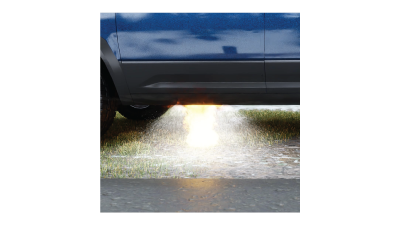VETS: the Vehicle Emergency Terrain Sprayer
A modification to a motor vehicle spray circuit that prevents utilization of the circuit in freezing temperatures.


Ready to License or Manufacture
The engineering and patent work is complete!
VETS: the Vehicle Emergency Terrain Sprayer is ready for licensing or manufacturing today.

Watch!
See VETS: the Vehicle Emergency Terrain Sprayer in action. This 3D animated video will provide a detailed look at the features and benefits of this invention.
Purpose
The invention is a modification to a motor vehicle spray circuit that prevents utilization of the circuit in freezing temperatures. When the temperature is below forty degrees Fahrenheit, the thermistor presents a closed circuit that does not allow the circuit, as well as the washer pump, to operate for safety.

Introducing VETS: the Vehicle Emergency Terrain Sprayer!
Contact us NOW to learn about manufacturing, retail, wholesale, distribution, or licensing opportunities for VETS: the Vehicle Emergency Terrain Sprayer.
Presents A Closed Circuit That Does Not Allow the Circuit and Washer Pump To Operate For Safety
Can Be Used on Emergency Vehicles with Underbody Spray Systems to Prevent Fires from Dry Vegetation
Eliminates Possibility of Accidental or Intentional Operation of Spray Circuit
Keeps Roadways Ice Free
Saves Lives
Story Behind the Invention
Inventor C.B. Breed of Fort Worth, TX has developed a modification to a motor vehicle spray circuit that prevents utilization of the circuit in freezing temperatures.
A vehicle sprayer circuit that wets down dry vegetation under a motor vehicle to prevent fires may be installed on emergency vehicles that have no choice but to travel on dry vegetation under emergency conditions. However, should the system be operated in freezing temperatures, either accidentally or intentionally, the liquid will almost instantly freeze, creating a dangerous sheet of ice on the roadway. Inventor Breed just knew there had to be another way. VETS: the Vehicle Emergency Terrain Sprayer is his solution.
But how does it work? When temperatures are high enough, the thermistor presents an open circuit that does not interfere with the operation of the circuit. However, when the temperature is below forty degrees Fahrenheit, the thermistor presents a closed circuit that does not allow the circuit, as well as the washer pump, to operate for the safety of the driver and everyone on the road.

